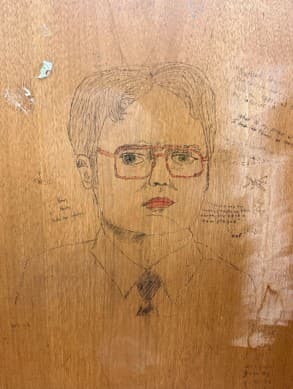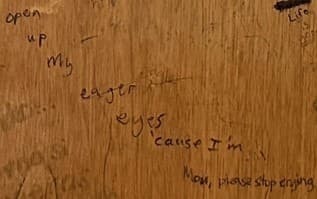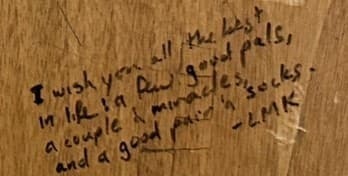Most students at the University of Notre Dame are familiar with the fourteen-storied Hesburgh Library, a place where students and professors alike can be found completing their daily assignments or collaborating on projects. However, the first floor’s modern design fades as you make your way up each story and history fills the space. Newly painted walls turn to yellow and stained, padded spinning-chairs become solid, wooden posture correctors instead of lounge devices, and bookshelves cram the space, turning each floor into a labyrinth of knowledge.
Not only does the library age as each story gives way to the next, the seemingly untouched first floor lobby becomes a plethora of student thoughts, feelings, hopes, frustrations, stresses, politics, and jokes carved or inked into the old wooden desks. Somewhat blundering your way through the maze of books, you will eventually find collections of wooden panels joined together in a manner that I can only describe as “study cells.” 3-inch thick wooden shields separate each desk from its neighbors, which I assume had the original intention of providing privacy and focus to the student who chose to study there. However, these shields have adopted a new purpose and have been “improved upon” by generations of students and their selected mediums: sharpie, pen, pencil, marker, carving, etc. At Notre Dame, the most vandalized spaces on campus, Hesburgh Library desks, are the epitome of student connection.
While seated on a squeaky wooden chair paired with a similarly designed desk, we are subject to the influences of previous students; thoughts, quotes, and drawings forever etched into the wood leave their mark on generations of students.

Comments such as “finals suck” or “Dear ND, Thank you for gray hair at 20 years old” provide a pathway into the minds of previous students and allow for a sense of empathy among current and future desk users. Just as researchers and archaeologists discover the patterns of life among past civilizations through artifacts, present-day students can connect with the previous generations and add their “2 cents” to the ever-evolving documentation of life at Notre Dame which is recorded in the wood of the library desks.
Students don’t only comment on their academic endeavors; they share thoughts that would otherwise be kept private. While working on my chemistry homework, I noticed a message that read “I’m in love with my best friend, but he will never know.” Reading such a personal remark made me recognize the power of leaving a message behind. The desks provide an anonymity that other forms of release cannot offer. With journals, your thoughts and statements can be tied back to you, but with graffiti, unless you sign your name, no one will know who is responsible for any comment. This form of journaling allows present students to look to the penciled-in words of past graduates as a means of validating their own feelings. In this way, the desks provide a means of connection between not only present students, but through generations of Notre Dame alumni.
The desks aren’t all marred by school stresses and unrequited love.

Humor is ever-present in the desks’ vandalism and elicits a smile (at least internally) any time it’s noticed. On the 9th floor, a glorious line art image of Dwight Schrute blesses the eye of any student who happens to walk past it. The unmistakable ode to such a widespread source of comedy undoubtedly sparks joy or at least recognition in those lucky enough to witness it. Dwight’s portrait is surrounded by “lol” and “you win” which signifies a connection between students that you don’t get anywhere else on campus.
There are no external pressures that prevent people from commenting on something they like or dislike. In the real world, someone might refrain from complimenting someone else’s outfit due to social anxiety or the possibility of awkwardness. In an anonymous environment such as the library desks, no one has to know who is tied to a comment or a drawing, leaving them unfiltered. Students can merely express themselves without feeling limited.
The desks provide a blank canvas for students as walls, train cars, and highways do for graffiti artists. Leaving an addition to the wood allows the students to establish their own sense of permanence and an infinite, concrete tie to the university. While the Notre Dame Alumni Association spans multiple generations and promises that every alum will forever be part of the Notre Dame community, many may also relish in the comforting thought that since their words or drawings remain, they cannot be forgotten.
Unfinished lyrics to the classic “Mr. Brightside” make an appearance on

the 12th floor with the wish of being completed. However, “open up my eager eyes, ‘cause I’m…” is met with “Man, please stop crying.” This somewhat failed attempt at “finish the lyric” provides another example of the humor the desks carry. Being one of the university’s traditional football game songs, the student’s choice to write the lyrics of “Mr. Brightside” creates a sense of community and belonging. Most, if not all students at Notre Dame know that singing this classic tune during a football game is one of the student section’s favorite events. When reading the lyrics inked into the wooden desk, anyone with the knowledge of Notre Dame’s connection to “Mr. Brightside” may recall a game memory or experience a sense of familiarity.
Notre Dame students have also expressed optimism and well wishes to their fellow peers,

creating an environment of support and camaraderie. I’ve seen numerous quotes, some of my favorites being: “I wish you all the best in life: a few good pals, a couple of miracles, and a good pair ‘a socks” and “Live like you mean it. Love ‘till you feel it. - the goo goo dolls.” Whether these students were truly making an effort to positively impact someone or were merely suffering from boredom, is uncertain. However, the result is the same. These quotes elicited a smile from me as I’m sure they did many others.
While Notre Dame prides itself on its founding history and tradition, the Hesburgh library desks provide a history of Notre Dame students, the foundation of community on campus. Father Theodore Hesburgh, whom the library was named after, was committed to developing the institution into a place of intellect and faith (An extraordinary life) since the university had previously been known for its athletic successes. Following Father Hesburgh’s plan for the library, its mission states: “Hesburgh Libraries cultivate curiosity and discovery as a hub for intellectual life. We advance the University’s research, teaching, and learning goals while fostering Notre Dame’s engagement with the global scholarly community.” However, I would argue that the statement is missing an important aspect: fostering student collaboration and community.
There is no doubt that the old study cells have provided a means of connection between students and their peers even if that wasn’t the original intention for them. Quite contrastingly, their construction seems to encourage a separation between desk users. The desks have fulfilled the Hesburgh mission of cultivating academic excellence by granting students a quiet, secluded place to study. However, it’s important to note that they’ve done so much more. From stress and frustrations to hope and humor, the desks have allowed for a timeless community to blossom.
For that reason, I propose an amendment to the current mission statement. The addition of “fostering student collaboration and community” to the statement would further support Notre Dame’s commitment to its students, faculty, and alumni. It would also set a precedent for continued community-building within the university; especially in Hesburgh Library.
With each school year, new students filter in and out of campus, creating a dynamic community, but a Notre Dame community nonetheless. The university proudly acknowledges its alumni network for almost every major event, promotes the successes of current students, and extends a warm welcome to future Notre Dame families. By doing so, the university creates the notion that Notre Dame is a compilation of its past, present, and future.
Through somewhat unorthodox and not fully supported means, students have found a way to foster community through generations and preserve the memory of past students. In doing so, we have supported Notre Dame’s commitment to its students and promoted the pillars of community and connection.
Some might view the old desks as disgustingly vandalized property; an unfortunate misuse of a study space. In a way, they would be right. Along with the documented stresses and warm wishes, are the classic graffiti encouragements to “commit tax fraud” and “do coke”. The desks no longer appear pristine and inviting as do the new study lounges on the first and second floors. However, what they lack in appearance, they make up for with substance. Beyond the surface-level defacing of school property lies a Notre Dame history that is separate, but just as significant, as the university’s founding. I want to be clear that I am not condoning the vandalism of any space on the Notre Dame campus. I am merely expressing my appreciation and acknowledgement of the history now embedded into the Hesburgh library desks.
What is the significance of the vandalized desks? Are they art? Are they merely defaced property? They are more than both. They are our history.
Works Cited
An extraordinary life. “An Extraordinary Life.” Father Hesburgh, University of Notre Dame , 2023, hesburgh.nd.edu/fr-teds-life/an-extraordinary-life/.
Mission. “Mission and Vision.” Hesburgh Library, University of Notre Dame , www.library.nd.edu/mission-vision#:~:text=Hesburgh%20Libraries%20cultivates%20curiosity%20and,with%20the%20global%20scholarly%20community. Accessed 12 Oct. 2023.

